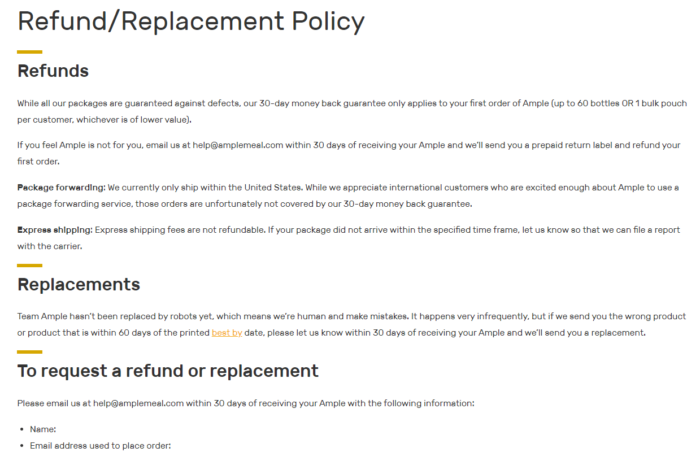Table of Contents
** Minutes
What is a returns management process?
Controllable returns vs. uncontrollable returns
Understanding the returns management process
How to stay profitable with your return management process
Returns tend to cut into profit and leave customers unhappy. In 2019, 48% of customers returned products purchased online, which resulted in $369 billion in losses.
Returns cut into profitability for many reasons. With every returned item, you have to account for:
- Taking on the cost of the return shipment
- Storage space for returned items
- Disposal of damaged items
- Losing a customer
- Negative customer reviews
As long as your online sales continue to grow, returns are inevitable. However, that doesn’t mean returns are the end-all, be-all. Returns also come with an opportunity to collect customer feedback, optimise internal processes, and provide more customer value. 92% of shoppers say they will buy again if the returns process was easy and overall positive — this statistic is worth exploring.
It’s time to debunk the idea that returns lead to lost profit and nothing more. The truth is not every return leads to a lost sale or customer. With a smart returns management process, there are many ways to mitigate or leverage returns to help support product development and improve the customer experience process. The result? Better products that keep your customers coming back.
The key is to create a customer-friendly return policy that builds trust with your customers while designing a returns management process that’s accurate, efficient, and dependable.
What is a returns management process?
A returns management process is designed to handle product returns for your online store, whether for an equal exchange or a full refund, and deciding what to do with an item once it’s returned. Many parts of the retail supply chain are impacted by returns, such as warehousing, inventory management, and profitability.
Controllable returns vs. uncontrollable returns
There are multiple factors as to why a customer makes a return. Customers return products because of preventable issues like defects, poor packaging that causes damage during transit, or they simply ordered the wrong item. Other times, customers will order multiple products, try them out, and return what they don’t want or need.
Depending on why the product was returned, you can categorize returns as controllable or uncontrollable.
Controllable returns
Controllable returns originate from how products are displayed online to how the product is shipped. For instance, when products are displayed on your online store with very little context or visuals, a customer may not have enough information to ensure they are ordering the right item or that they even like the item.
Or, an issue can occur during the retail fulfilment and shipping process, from the item being mis-picked due to poor inventory management, damaged while in transit due to poor packaging materials, or misshipped to the wrong address.
From adding high-quality visuals and information about every product on your website to choosing a fulfilment partner that picks and packs with care, controllable returns can be mitigated. Ultimately, the goal is to prevent problems in the first place.
Some of the way ecommerce brands reduce returns include:
- Improved dunnage and packaging to prevent shipping damages
- Working with suppliers who are known for having high-quality products
- Ensuring that packages are being fulfilled with extra care
- Working with couriers that are known for delivering packages undamaged
- Easy-to-read and accurate size charts for clothing
- Proper order tracking so customers know when they will be delivered
“We use the locations that optimise and reduce the distance travelled to get our products into our customers’ hands faster. When shipping glass bottles, especially in the winter, the longer the transit time, the more likely it is to break. We see that our customers are getting their packages safer, with fewer frozen bottles exploding.”
Lindsay Louise, Fulfilment & Retail Manager at Synchro
Businesses can eliminate the root causes that result in a return by getting in front of what they can control.
Uncontrollable returns
Uncontrollable returns occur when it’s out of your control. This is seen a lot in the apparel industry, especially with online sales. The customer may order the wrong size or purchase a number of items with the intention to return what they don’t want. Also known as “serial returning,” customers may order multiple variations of the same product, keep the one they like, and return the rest.
Uncontrollable returns often increase during the holiday season when people are buying gifts for other people and are given a gift receipt, which makes it easier for the gift to be returned. In fact, 5 million packages are returned to retailers in the first week of January — a fact you’ll want to consider during the holiday shopping season.
Understanding the returns management process
The returns management process is sometimes referred to as “reverse logistics.” This is the opposite of shipping products to a customer, as the customer ships a product back to you. In most cases, returns management follows a simple three-step process but can be further streamlined based on the unique needs of your customers and your business.
Step 1: A customer initiates a return
The first step is on the customer to complete. With the instructions given (which should be stated clearly on your returns policy and easily found on your website), a customer will start the returns process and give context as to why they’re making a return.
This is a good opportunity to prompt customers into taking a survey that asks for feedback. By collecting returns data, you’re able to gain insight into products on why they’ve been returned and make changes to help prevent this from happening again or as much.
Depending on your returns policy, a customer may be given the option to receive a full refund, replacement, or store credit. From there, most online stores offer the customer a printable return label (47% of online shoppers want an easy-to-print return label). Then, the customer can use whatever packaging they have to ship the product back.
Step 2: The returned product is received
Next, a customer sends the return directly to a predetermined location: a fulfilment centre, a retail location, an ecommerce warehouse, or even sometimes an ecommerce seller’s home. Whether you manage returns yourself or your fulfilment provider manages them on your behalf, you decide what to do with the product once it’s received: restock it, repair it, recycle it, quarantine it, or even donate it.
Step 3: The return is processed
From here, it’s important to act quickly. If the customer qualifies for a full refund, be sure to process the refund as soon as possible. If the customer requested an exchange, ship out the updated order right away. If the item returned is applicable for resale, mark it as available inventory so you don’t lose out on a potential sale.
How to stay profitable with your return management process
By looking at returns as a way to generate customer loyalty, improve brand experience, and even enhance internal processes, returns can lead to an opportunity to drive more revenue in the long run. Here are some ways to optimise the return management process.
Upgrade customer service
When a customer returns a product, use this opportunity to connect with them and get feedback on why. By taking the time to follow up with unsatisfied customers, you’re given the chance to build brand loyalty by building trust. You could also offer an incentive for them to purchase a product that better fits their needs using store credit (e.g., a discount code).
Invest in inventory management
With so many customers adopting ‘try and return’ habits, your business needs to have inventory adequately managed. Make sure to always have returns that are resellable marked as ‘in stock’ and that you have enough storage capacity. If you’re experiencing a high volume of returns, it might be time to invest in inventory management software, which can help you manage inventory in real-time.
Educate your staff
If you have employees who process returns for you, work with them to find ways to make the returns process more efficient. For example, if products are consistently being returned due to damages while shipping, your team can experiment with improved packaging options and dunnage to prevent damage for future shipments.
Include a clear return policy on your website
58% of customers say they want a hassle-free return policy. Many customers ordering from your ecommerce site often check out your Returns Policy before making their first purchase. Have clear instructions for customers to follow, and be honest about expectations, costs (if any), replacement items, store credits, and delivery times once products are returned.
Here’s an example of ecommerce return policies:
Meal replacement brand Ample Foods

One issue with returns is some customers use it as an opportunity to get products for “free.” By ordering a product they claim is damaged or defective and then demanding a refund, they get to keep the product and get their money back. Ample Foods combats this by making customers return their products if they want a replacement or a refund. View the full policy here.
“We were working with a competing 3PL that had a good distribution network but did not keep promises and had a lot of order errors. As an emerging company, brand recognition and loyalty were key to our business, so we ultimately decided to move to ShipBob. From day one of transitioning to ShipBob, we’ve appreciated the hands-on time spent with us.”
Pablo Gabatto, Business Operations Manager at Ample Foods
Looking to optimise your returns management process?
Since returns tend to cut into profit, it may be tempting to eliminate returns entirely. But since returns can either make or break future sales, a proper returns management process is worth the investment.
Here’s why — businesses that invest in improving their returns processes see a 12% increase in customer satisfaction and a 4% decrease in cost.
Although it’s worth investing time and money, improving your returns management process can be a huge undertaking. That’s why many ecommerce brands partner with a third-party logistics (3PL) partner like ShipBob to better manage returns. ShipBob’s fulfilment solution can handle returns for you or lets you manage returns on your own and even easily integrates with leading ecommerce returns platforms such as Happy Returns and Returnly to better streamline the returns process.
“About a year and a half after building out our business, we figured it was time to optimise some of our processes, including returns. The ability to work with one of the co-founders of ShipBob to launch a new, custom returns process was awesome. Returns were taking a lot of time and resources to process on our end, but ShipBob was super helpful and critical in creating a solution for us.”
Nikolai Paloni, Co-Founder of Ombraz Sunglasses
Here’s how ShipBob helps support ecommerce businesses with returns management.
Have returns restocked, quarantine, or disposed
ShipBob offers more control over your returns management process. ShipBob merchants have the option to restock, quarantine, or dispose of returned products at the SKU level. This means all you have to do is choose how you want each individual product to be processed and our team will handle the rest.
Easily track returns
No matter how many ShipBob fulfilment centres you use, all returns can be created and tracked from the Returns page of the dashboard. From here, you can view detailed information and track the return by the returned item’s ID.
You’re given the option to purchase our discounted labels
Merchants working with ShipBob get shipping discounts from couriers including UPS, USPS, FedEx, and DHL. This applies to shipping for return orders as well. However, if you get your own labels, it’s only a small processing fee with ShipBob. For more information on ShipBob’s returns pricing, click here.
Conclusion
No ecommerce business can prevent 100% of returns, but there are ways to make the returns management process easier and more profitable. Instead of viewing returns as lost sales, think of them as an opportunity to improve your products and create a remarkable brand experience.
“For reverse logistics, we have also been leveraging ShipBob’s Returns API to automate and streamline our routine RMA processes. Having ShipBob handle our returns has been a huge help in reducing our daily workload, and the ability to drive this process via API is wonderful.”
To learn more about how ShipBob can help you manage returns and other inbound and outbound logistics processes, click the button below to request a quote.



